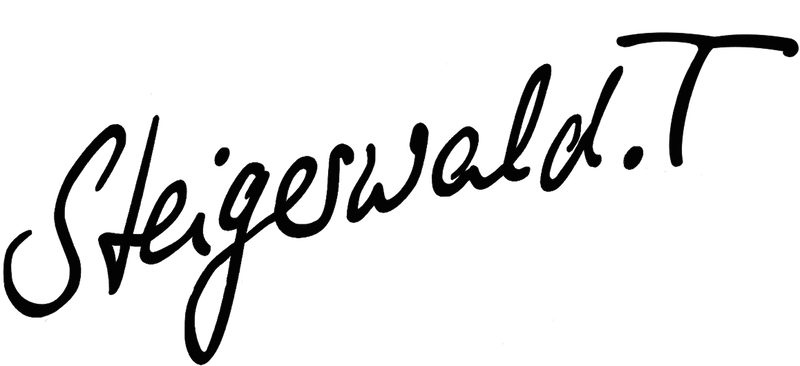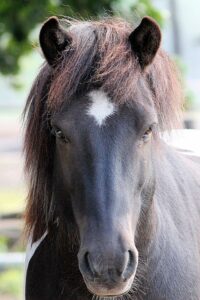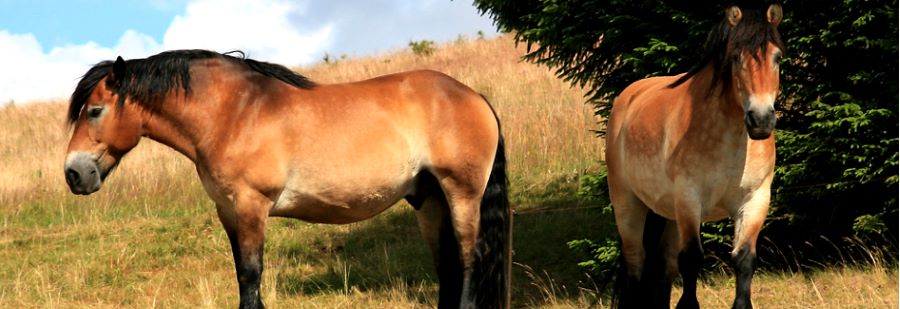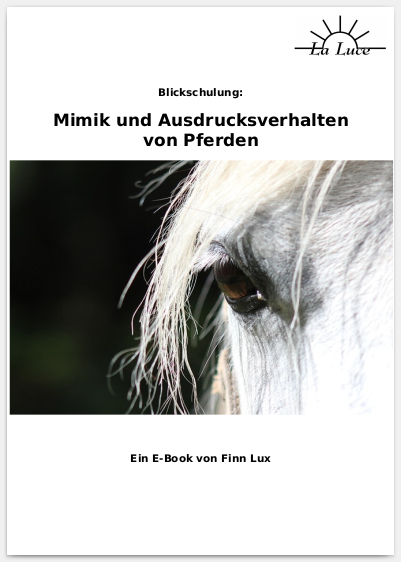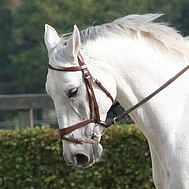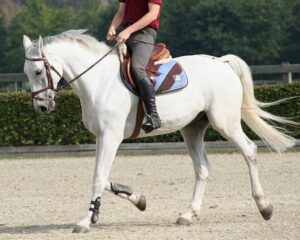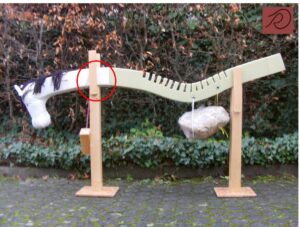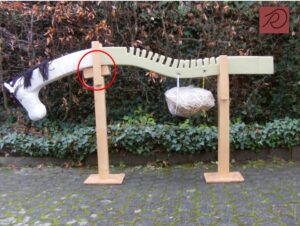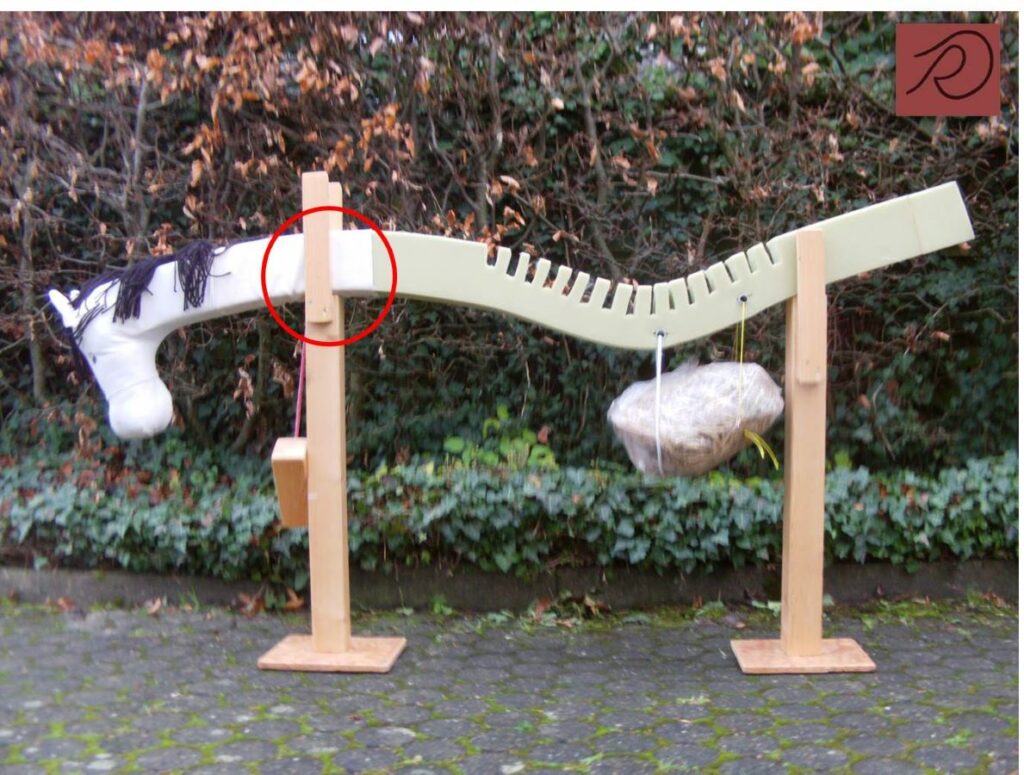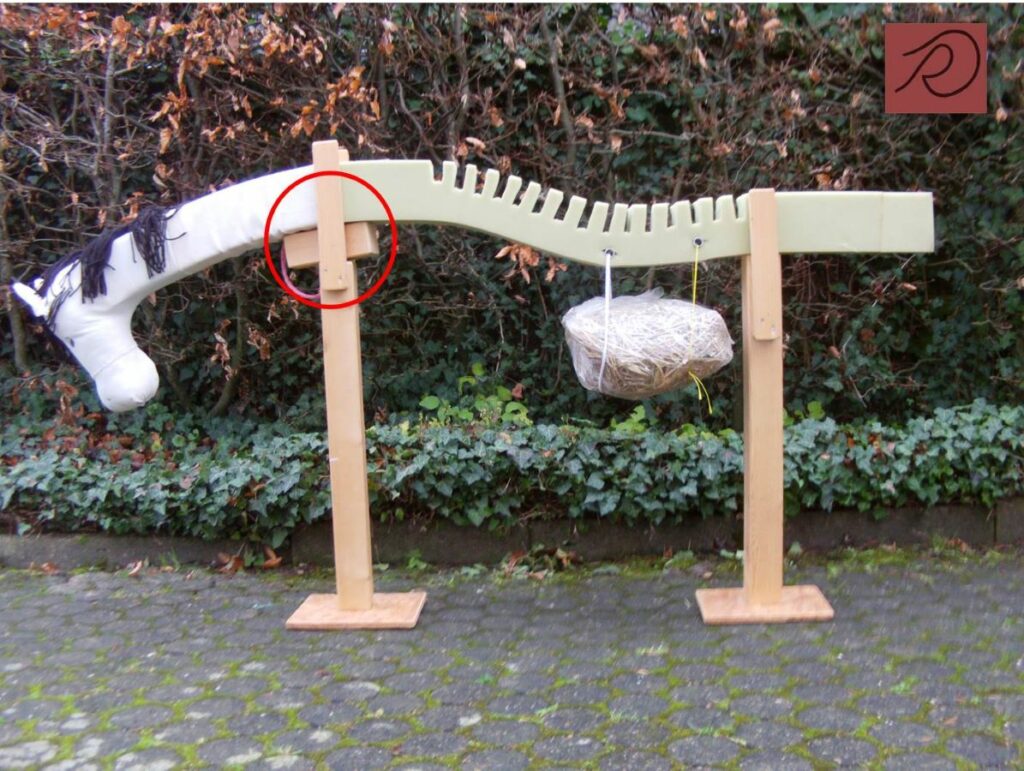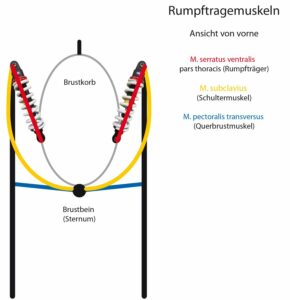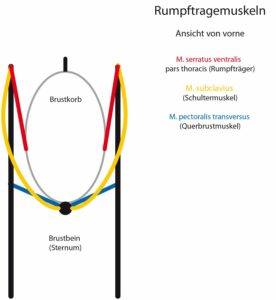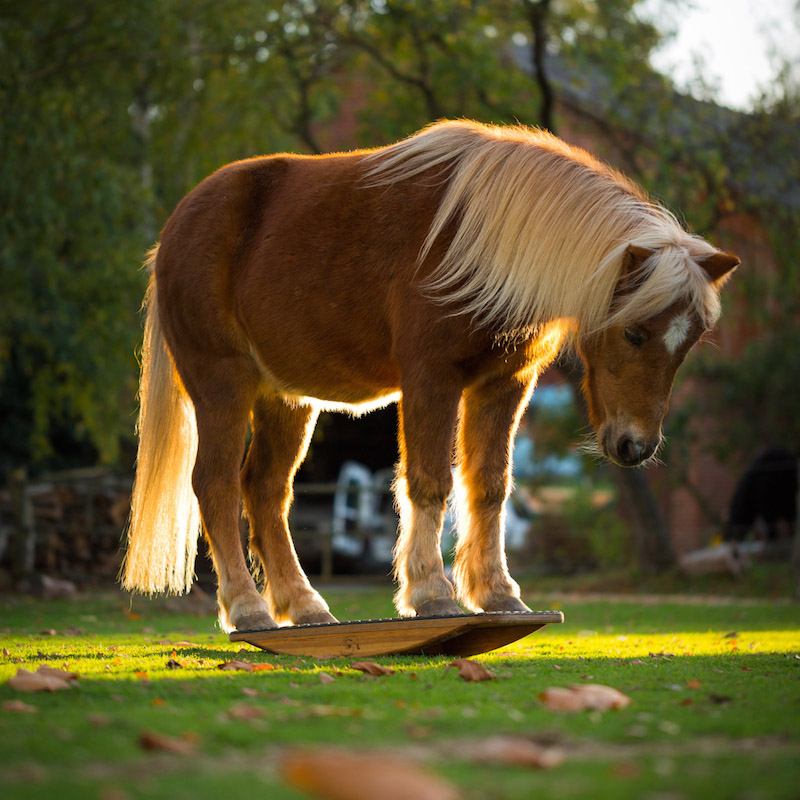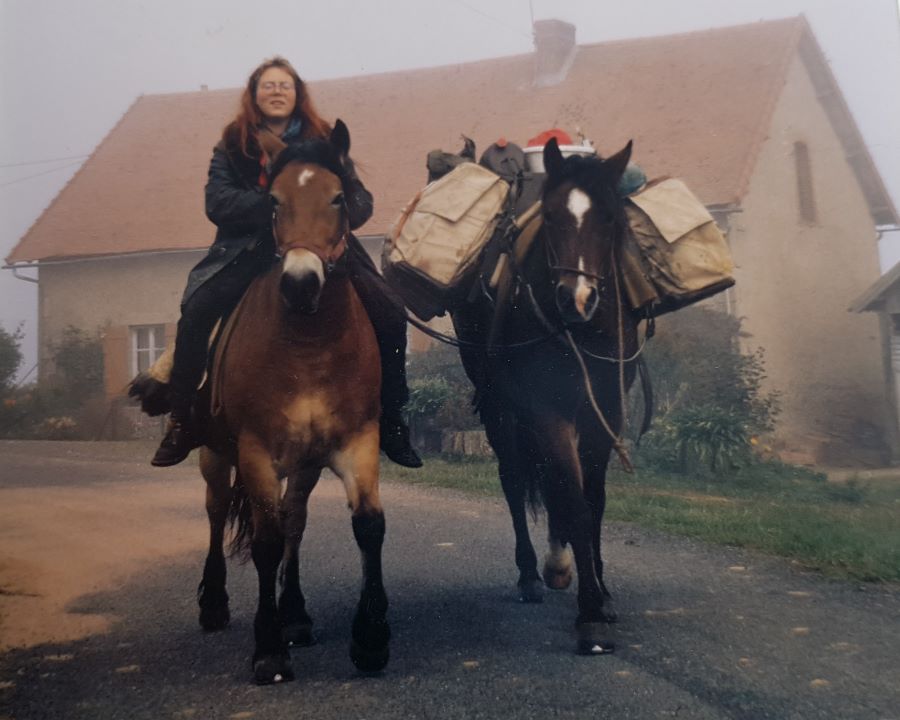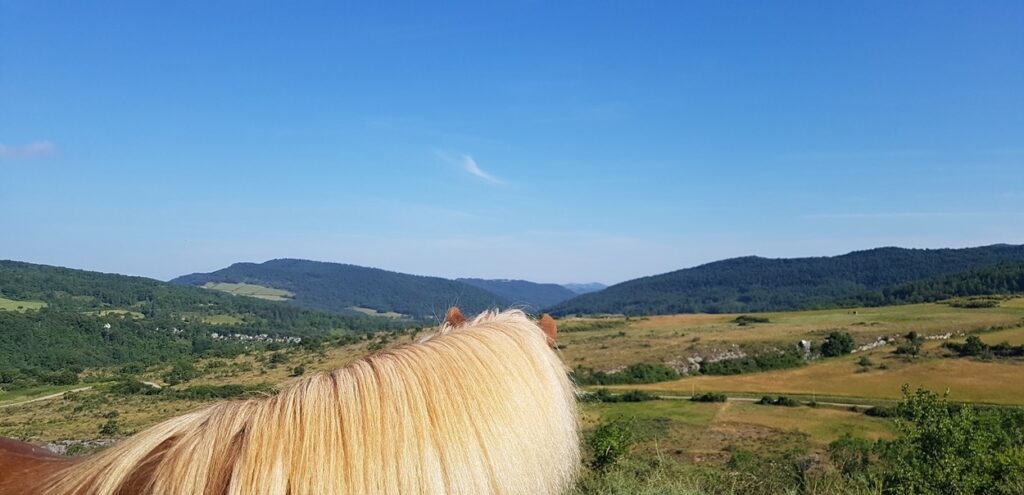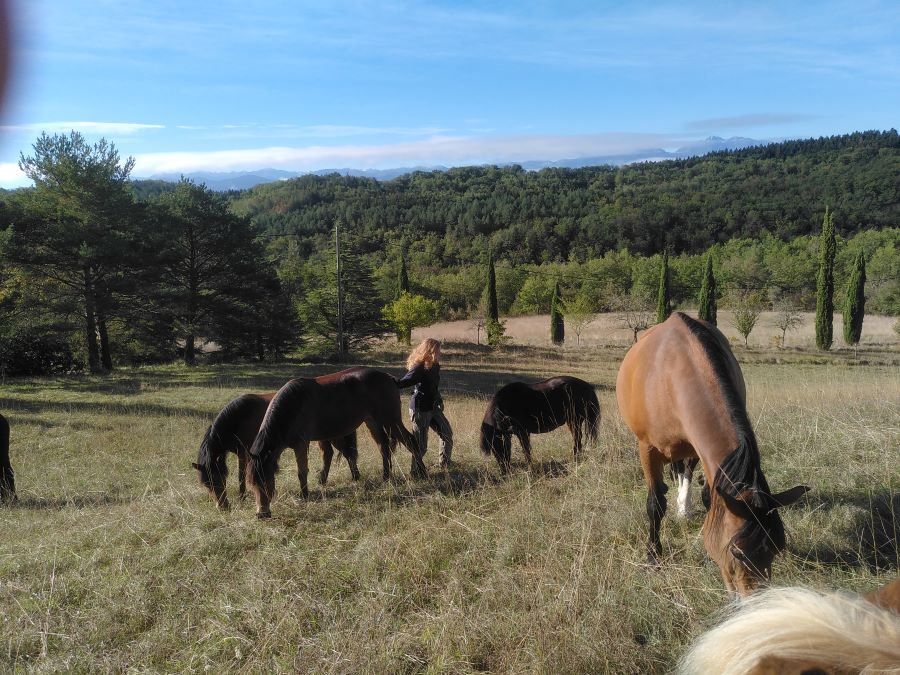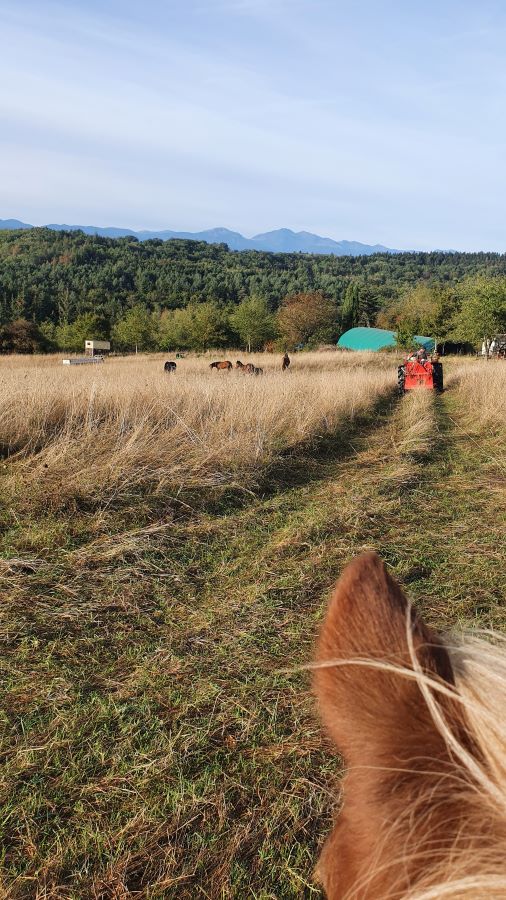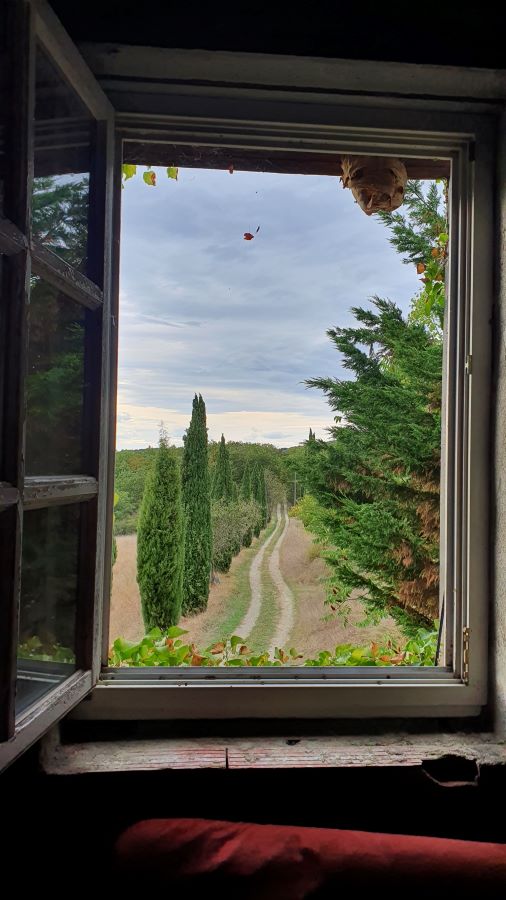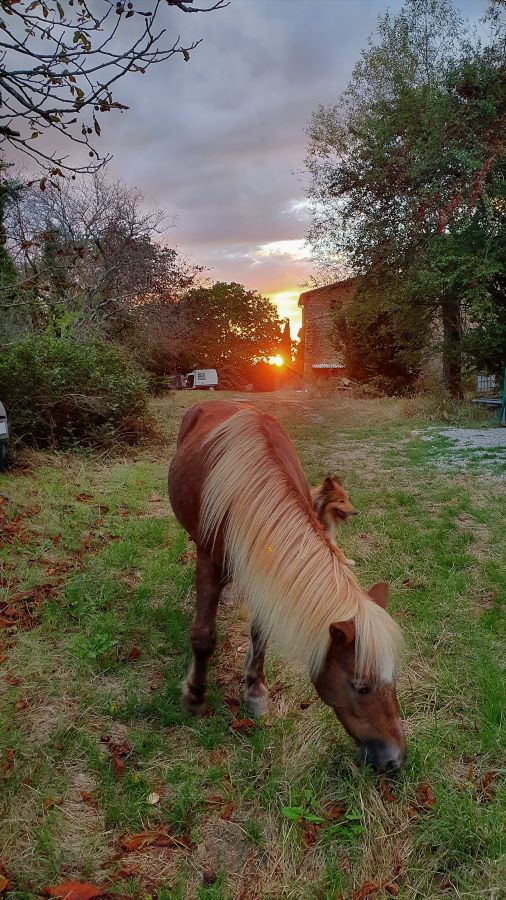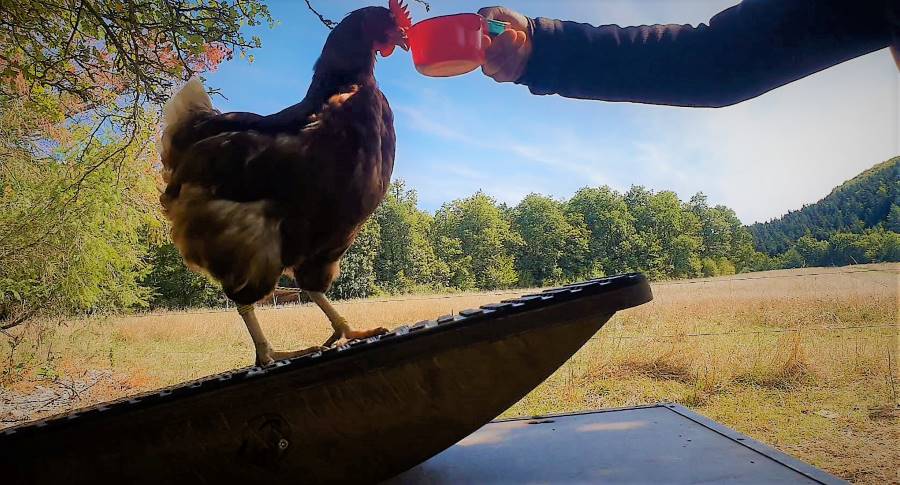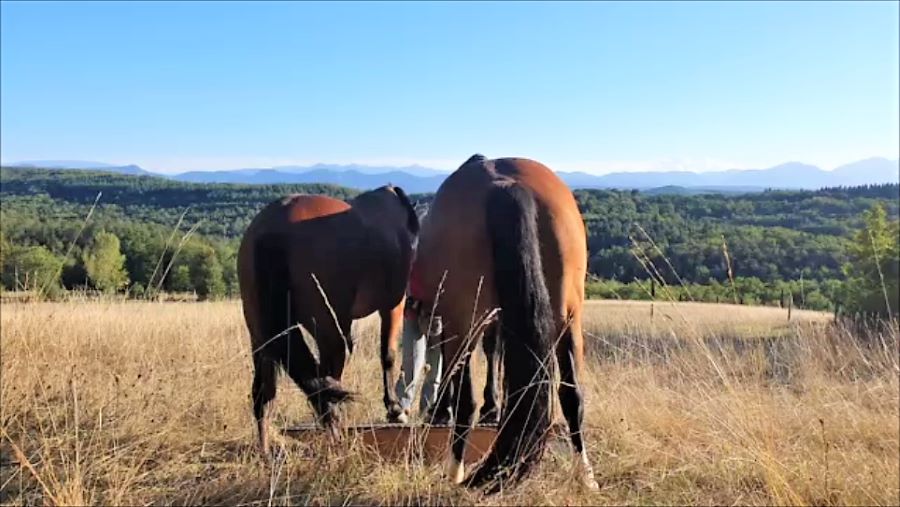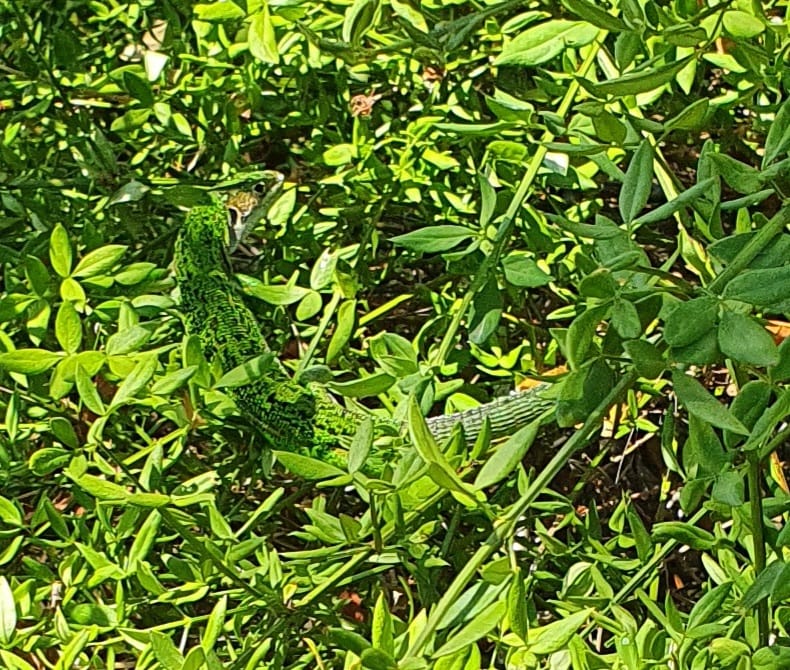Technical paper by Finn Lux: Facial expressions and expressive behaviour of horses
Can you read your horse’s facial expressions?
Technical article by Finn Lux
This is a question I have been dealing with a lot in the last few years. In fact, the study “investigating equestrians’ perceptions of horse happiness” by Tanja Bornmann (2021) showed that 93% of the riders surveyed falsely described stressed horses as happy.
Personally, I was shocked by these figures. At the same time, in my everyday life as a trainer, I unfortunately actually see mostly horses with stress facial expressions or pain fuses. Be it in the boarding business, on the showground or in the local children’s riding school.
Unlike dogs or cats, for example, horses have no sound for pain. As prey animals, they also try not to show it. This is because an ailing horse would be the first to be attacked by the predator. If a horse is lame, it can therefore be assumed that it has been suffering from pain for a much longer time, but has been able to hide it successfully so far.
For our domesticated horses, this means that we humans often do not even notice that they are not well and train over their needs. Horses are often labelled as lazy, bitchy or stubborn without recognising the actual cause of their undesirable behaviour.
Basically, I first assume that riders and horse owners love their animals and do not want to harm them. Therefore, I see the problem in a lack of education and it is a project close to my heart to change something about it. To spread knowledge based on scientific facts without criticising individuals.
Much more, I would like to offer help for self-help. I want to give horse people the knowledge they need to recognise that a horse is not doing well. What they then do with this knowledge is up to each reader.
This is how my e-book “Mimic and Expressive Behaviour of Horses” came into being, which I published at the end of January 2023.
I also clear up the issue of concentration in my book. Concentration is often used as a justification for recognisable tension in a horse’s face, but in fact it hardly shows at all in the horse’s facial expression. Only the alignment of eyes and ears as sensory organs reveal what a horse is concentrating on at the moment.
Tense chewing muscles, flared nostrils, worry lines over the eyes, earlobes pressed against the base of the skull … All of what is often called a concentrated facial expression by trainers and riders is actually an expression of stress, pain and discomfort.
Another problem I see is that the social media, but also photo calendars or posters in the children’s room predominantly depict stressed horses. Why is that? Obviously, the sight of a relaxed, happy horse is too boring for us. Does it always have to be action? Higher, faster, further?
The result: we get used to what we see all the time. Our brain stores the stressed facial expressions as normal and we no longer even notice a horse’s discomfort.
I wish I could encourage more people to question. Perhaps in the future you will consider what you base your assertion on when you say or think that a horse is just fine. What scientifically proven facts confirm this hypothesis?
After all, we all want one thing: for both rider and horse to have fun.
I would like to thank Finn very much for this important contribution to our blog! Even or especially because it can be uncomfortable for many horse owners to face up to it (93%!) and say goodbye to old beliefs, this topic really deserves our attention, because we all want the best for our horses after all.
Technical paper on carrying weakness by Karin Kattwinkel
How good is your horse’s back? Is it strong enough for the rider’s weight or tired and weak?
Article by horse health trainer Karin Kattwinkel (Dipl. Ing. agr.)
Have you ever asked yourself whether your horse can really carry you? And if so, how long without suffering damage? Are horses actually strong enough by nature to carry a rider?
Certainly not the latter. Because they are “constructed” by nature as grazing animals without a load on their backs. Because their food was originally quite low in energy (steppe grass) and they had to move many kilometres day in, day out to get their fill and find water, they carry more than half of their own weight without having to use muscle power thanks to the neck-back ligament system and some ingenious details in the skeleton. The longer and lower the neck is carried (grazing posture), the less effort is required. In this posture, more than half of the rider’s weight is carried without muscular effort. But also the wide forward stride of the hindquarters makes it easier to carry the rider’s own weight (and also that of the rider). That is why forward-downward riding and skilful driving towards the bit are guarantors for healthy riding horse backs. Unfortunately, you see them less and less.
Pulling” in the front and “stabbing” in the back is just as damaging as “riding without contact”.
Where ambitious sport riders and imitators pull the horse’s neck short and the nose behind the vertical, the horse’s back is definitely tense. But many recreational riders who deliberately do not want to make these mistakes are also harming their horses. Long riding on a loose rein and/or too little driving also makes the horse’s back tired.
Many horses get into a state of weakness at a young age because they have already been loaded with rider’s weight during unfavourable growth phases and had to “walk on the reins”. Then you buy this old burden with them, so to speak. Most horses do not get out of this condition on their own.
How to recognise carrying weakness
This is when the chest and back sag downwards. This overloads the chest muscles and overstretches the neck muscles. The shoulder blade muscles tense to achieve stability. The croup muscles pull to lift the back from behind. The hindquarter muscles (trouser muscles) pull to stabilise the pelvis. They are often overdeveloped. Often the carrying weakness is associated with blockages in the base of the neck and the neck joints. It is often caused by improper and too early breaking in.
Other or additional causes can be
- Too heavy a rider
- Too much weight of the horse itself (pasture belly, pregnancy)
- Riding for too long for the horse’s current state of training
- Too short and/or always the same rein measure
- Use of short and/or rigid auxiliary reins
- Clamping saddle
- Clamping rider
- Active rearing with the hand
- Disharmonious hoof balance
- Pain in the legs/hooves
- Lack of impulsion from behind (hindquarters do not go under)
What to do when the horse’s back is tired?
Any measures that reduce the pressure on the back, allow the back to stretch, stimulate the abdominal and thoracic muscles to work again and activate the hindquarters are helpful.
These include:
- Working freely or on the lunge line without a saddle and without a girth at a brisk pace (after the warm-up phase) with many transitions between gaits and at the pace of each gait.
- Initially work only on large lines
- Include cavaletti and small jumps
- Extensive walks in the countryside or as a hand horse
- Circus lessons: Bowing, complimenting, platform work (only front legs on platform, important: mount with low head)
- Work on the hand: Shoulder in at a walk alternating with voltes
- At the earliest in 3 months, cautious re-start (light, well seated rider, optimally fitting saddle, lots of cross-country – uphill and downhill, calm cantering)
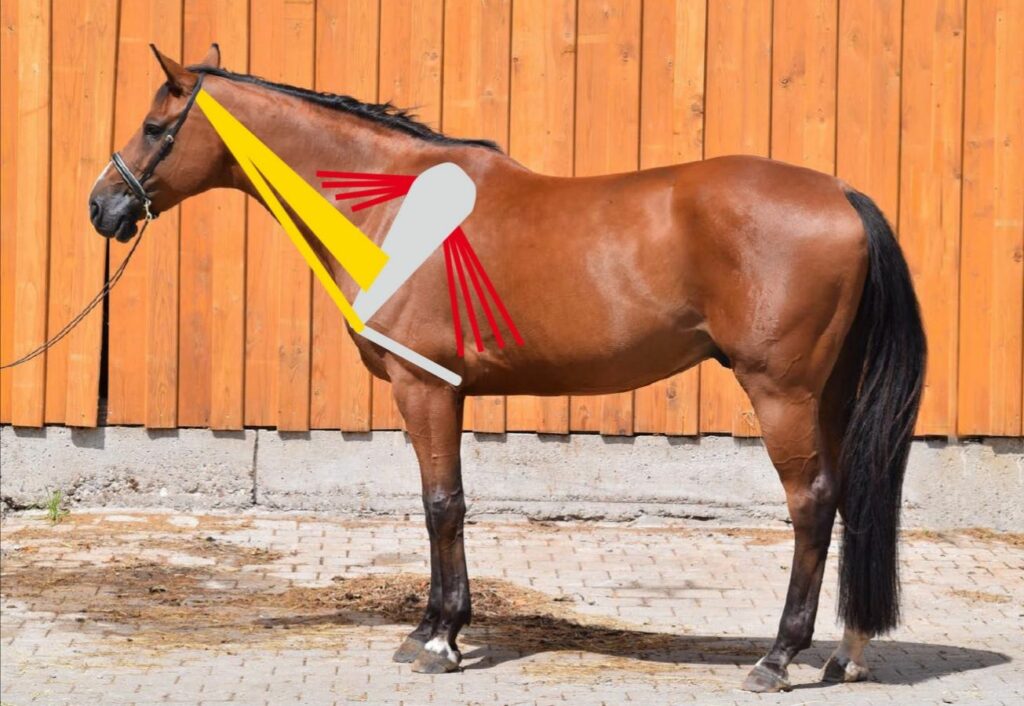
red: m. serratus (neck part and thorax part), yellow: long hyoid muscle and neck part of the m. longissimus, grey: scapula and upper arm (Photo: Peter Selbach)
Rocking helps: By rocking back and forth on the seesaw, many tensions are released and the coordination of the muscles improves. It is a varied exercise for horses.
Longitudinal rocking strengthens the ventral muscle chain and relaxes the topline.
Lateral rocking strengthens the thoracic and thorax stabilising muscles.
The build-up phase should be accompanied by physiotherapeutic exercises such as lengthening the topline via tail traction, lifting the belly via provocation with the fingers along the abdominal seam, closing the hindquarters in stance as well as circus lessons such as bowing or standing with the front legs on a platform while eating from the ground.
More info on this and many other topics at www.equo-vadis.de. Recordings of the webinar series “Raus aus der Trageschwäche” as well as the hybrid calendars with step-by-step plan for therapy and training including instruction videos www.equovadis-shop.com.
FB group “Raus aus der Trageschwäche”.
I would like to thank Karin very much for this important and informative contribution to our blog! It is such a significant topic and really deserves our attention in training.
If you want to offer your horse exceptional deep muscle training, mobilisation and fun rehab (or prevention!), we have another very special offer for you here: The Steigerwald.Trainer for horse rocking will start soon. Here you will learn from the beginnings to the challenging lessons how to use the horse rocker in an optimal and versatile way for health maintenance, rehabilitation training and muscle building. I will accompany you and your horse individually and closely, which is why places are limited, so take your chance and invest in your horse’s health!
Comprehensive online health course with horse seesaw
In February, the Steigerwald. T seesaw trainer starts as an online course. It is suitable for everyone who wants to take this wonderful full-body workout to a really good level with their horse.
A lot has happened since I invented skid rockers for horses in 2014. Initially dismissed as a crank or a gimmick, more and more horse people are becoming aware of horse rockers.
The advantages are manifold! For example, you can train regardless of ground conditions. The arena is muddy or frozen? No problem with the right Steigerwald.T rocker frame. Are the horseflies pestering you and your horse outside? Train indoors. The small space requirement of a horse rocker compared to what you need for riding, lunging or manual work is a real plus.
In addition, training with horse rockers is suitable for all age groups. A young horse easily and playfully learns to know and consciously move its body. Not everyone can offer their horse varied trails. If it lives on an average paddock and a “normal” horse pasture, sensorimotor stimuli are missing. However, these are important for the development and maintenance of a good body feeling.
A large part of the health problems of horses is related to the musculoskeletal system. Training with horse rockers makes an important contribution to prevention and is used very successfully in rehabilitation.
Recently, a veterinarian reported that horses in the brine chamber on the seesaw are much better at sliming down. Rocker training not only has a positive effect on the musculoskeletal system, but also influences the internal organs. These are partly “suspended” from the spine by fasciae and are gently massaged and activated during rocking.
But how do you get there with your horse? As always in life and in training, many roads lead to Rome and I would like to make it possible for all horse lovers to find out and successfully follow the path that suits their horse with the rocker trainer online course. The biggest challenges are beautiful, flowing rocker wapps and correct hank flexion for the advanced riders.
You can expect the following contents:
- Prerequisites: Politeness, walk along, stop, stay
- Moving with feed points
- single steps forward and backward
- Moving hooves manually (modelling)
- Tail and nose target
- Walk on limited ground
- Reduce padding and stabilisation
- Create luffing movements
- Transitions to independent rocking
- Extending independent activity to the target: Ten flowing teeter-totter bends
- Two-legged bob for the forehand
- Two-legged rocker for the hindquarters
An all-round carefree package! Simply everything you need for a healthy and sound training with a horse from the beginning up to the really demanding lessons.
You’ve already bought an existing webinar on rocker training and you’re not sure how much is new? Don’t worry, for one thing: This course is much more comprehensive and special: I personally coach you and your horse on your way. On the other hand: All purchasers of an existing webinar on seesaw training will receive the full purchase price credited to the online course!
Not all details have been finalised yet. However, it is certain that we will limit the number of participants so that I can coach you individually. So if you already know that this is the right thing for you and your horse, take the chance and secure your place for more health and joy of movement: Steigerwald. T seesaw trainer as an online course
About the courage
“That’s pretty brave.” “I admire your courage!“
I often hear and read sentences like that. On the one hand, I am happy to receive positive feedback on our emigration, or rather on our decision and the implementation of it, but on the other hand it also makes me think.
In an interview with the brain researcher Gerald Hüther, I once got to know a somewhat different view of courage itself or of courageous deeds. It is very much in line with my own perception. According to Hüther, people only need courage for deeds they don’t actually want to do. I have always felt that I was not particularly courageous. Not even in 1991, when I rode alone from northern Germany to southern France with two horses and two dogs one month after graduating from high school. It was not a walk in the park for me from a mental point of view. Day after day, steering the horses’ steps towards the south, never knowing what encounters fate had in store for us at sunset. Towards a distant and completely unknown destination. I only knew that I had to do it. Do.
And it’s the same in 2019, when on my first visit to Matou I felt “this is it.”
Have you had this feeling once or several times in your life? Something that occurs not as a wish without an effective will, but as a certainty? Or have you let your life and circumstances develop as they did? Decisions rather always made as reactions to the wishes of others and “society” and circumstances? What does the saying “The world belongs to the brave” mean? Do you own your world?
In this view, one aspect certainly applies. If you want to give me the label “brave woman”, it is true that I have often created a world in my life that was really mine. It belonged to me in a positive sense, it had above-average aspects of life to which I could say “yes!” with all my heart. The fulfilment of none of my dreams elevated me to the mental Olympus. There were many challenges, glaring problems, adversities, but the basic chant was always that of the right film. My world. Because I had chosen it and was willing to bear the consequences of my actions.
A few years ago I attended a lecture by Reinhard Sprenger. He began, “Would you rather be on the beach in Hawaii right now? The good news is that you can be on your way there in a few hours. If you say “I can’t” now, you are just shying away from the consequences. That you’ll be out of a job, your bank account will be overdrawn, your wife will think you’re an a… and your kids won’t have anything to do with you anymore, as an example. But you can go to Hawaii. If you accept the consequences.”
The consequences of emigrating to the South of France can be of a similar nature to those Sprenger is talking about. If Mario’s and my move is now called courageous, it could mean that the speaker feels that these kinds of consequences are not bearable for him or her. It would then cost him or her courage to embark on such a path. But what if the consequences are not as bad and serious as feared? What if the positive and good in it carries strongly and nourishes the soul?
If you are thinking about changing something in your life, but you are in the “courage-if-I-didn’t” mode, the following exercise may be helpful for you: Take two sheets of blank paper, write down on one the hoped-for positive consequences of your idea or dream and on the other the feared negative ones. Pay close attention to your feelings as you write and imagine what this step would mean. Weigh and ask yourself again and again: Which is stronger?
Sprenger again: “A certain willingness to take risks is the prerequisite for creativity and innovation. Inner motivation arises of its own accord when people do what they do best and what they would voluntarily spend their time doing.”
What do you like to do and do well? What do you think you need courage for? These and other questions will be explored during the “Le Matou Experience Week”. An unforgettable stay with body, mental and soul work and of course the six horses and chickens awaits you from March 2023.
Would you like to be part of it? Be one of the first to seize this opportunity? Write me an email and we will talk about your questions, wishes and ideas and who knows, maybe you will find out that this is exactly the right offer for you!
This offer will not be available in the shop for the foreseeable future. It is much more than a further education, it is an invitation into my home, an insight into my world… personal contact comes first. I look forward to hearing from you!
October on Le Matou
I left for Germany at the end of September, on the trailer firewood for friends in Germany. Mario gets the firewood from our forest and at the moment there are enough dead trees to be found so that trees don’t even have to die for a heated stove. Mario has also installed the solar system on the roof and with the good weather here in the south we can be optimistic!
The project “wood finishing” is taking shape, some conifers are ready to be harvested on the property of a Belgian friend. The sawmill, where the oaks for our rocker skids are also sawn to size, is to be mounted on the big trailer. This way, Mario can not only saw up our own wood for various construction projects still to come, but also saw the desired dimensions directly on site at different places.
While I visited our son, family and friends and had a lot of fun teaching, Mario and our intern Lilly stocked our experimental raised bed boxes. At the barn, we hayed down, collected it in a paloxe (a mixture of grid box and pallet), put 30 cm of soil on top as the top layer-et voila, the seeds for the winter vegetables can be spread. If the wild boars get too close to the house, it is still safe. Next year, when the chaff has rotted, we will hopefully have decided on a place for the garden and can empty the paloxes there.
What will also accompany us for a long time are the paths on Le Matou. Fortunately, we now have an “epareuse” to keep the existing ones clear. If we wanted to do it all manually, we wouldn’t need any other hobbies. There are some old ones to discover, uncover and repair.
In addition, we have the dream project that one day a passable – i.e. with a very off-road vehicle – path should run along the outer border. Which, of course, can also be used by horseback, mountain bike or on foot. So far, Mario continues to fight his way through the undergrowth with the Jimmy and is definitely having a lot of fun.
The small all-terrain vehicle is also the transport means of choice when it comes to fetching clay to the house. Lilly plasters the walls of the upper shell with it. Next year, when the first “Matou Experience Week” begins, it will eventually serve as a common room and hostel.
We are planning stays with a less focused training emphasis, but more into the theme of quality of life through awareness and well-being. The planning of activities then needs to be well coordinated. When some are playing with the mini-excavator, others are doing their training with the animals at the opposite end of the property… A big plus in experiencing also happens through silence, through noticing everything that is around you. And that completely without any machine-made background noise.
Under this sign of the challenges of the “civilised world” are also the tasks with the ponies and Jupiter after my return. The New Year’s Eve Challenge helps our animals to cope with the events of their not always animal-friendly environment. Would you like to support your animal too, or are you just curious what it’s all about? Then take a look here: New Year’s Eve Challenge
Steigerwald.T New Year’s Eve Challenge: Impulses and their control
Does your pet also suffer on New Year’s Eve? Do the unfortunate noise, the light stimuli and the stench trigger strong fear reactions in him? I have repeatedly read on Facebook about fatal colic or injuries at the turn of the year.
The good news is that this does not have to happen! You have a good deal of control over preparing your beloved four-legged friend for this event with its terrifying effects. Back in 2019, I launched the New Year’s Eve Challenge. Through the training of at least thirty different acoustic, visual and also olfactory stimuli, our animals learn that it is not so bad after all. On the contrary, through so-called operant conditioning, your pet may even have pleasant feelings when it hisses and bangs. This is because, unlike methods such as “pooping out”, the reactions of the animals are taken into account.
The procedure is as simple as it is captivating: You wave a balloon, for example. When your dog, horse or cat stays relaxed on the spot or lies down, you click and give him a little bit of food. Through the number of repetitions, the idea of “Wow, that’s worth it!” builds up in the brain. The perceived stimulus becomes an announcer of something good.
Now, of course, your pet may immediately flee at the sight of a wildly wiggling balloon and you may not even get around to rewarding holding still. Then the key is to reduce the stimulus. You can do this by putting more distance between you and him or, in this example, simply holding the balloon up. Believe me, there is always a distance at which your animal can control its impulse to move away from the stimulus. You can find out exactly how to do this in the Challenge webinar.
You don’t have to set off fireworks to train fireworks either. The Challenge process leads to generalisation. With sufficient variability and quantity of stimuli, your animal will put the firecracker in a drawer with everything that you have linked as pleasant in the weeks leading up to New Year’s Eve through targeted training.
It is said that behaviour is driven by its consequences. In the wild, our animals would move as far away as possible from fireworks because the consequence of flight is relief. And it is more than understandable that they want that relief so badly. As a self-confessed country bumpkin, I can only confirm this. But what if the relief cannot come because a fence or the walls of the home prevent escape? Faintness and fear are the result, the impulse to flee looks for another way, the animal is helplessly at the mercy of its fear and does not know what to do with itself.
Through intensive training, you offer alternatives to escape and help your animal to see the “civilised” world differently. Create pleasant consequences for relaxed reactions to a variety of stimuli. Always increase them so that your animal can still say “yes!” and accompany it on the path to self-efficacy.
Register here for the Steigerwald.T New Year’s Eve Challenge and receive valuable tips for your training and the support you need to give your pet a relaxed start to the new year.
And while we’re on the subject of giving gifts: I really care about the well-being of all animals, so of course I will reward your efforts for your darling! See “Special Callenge Bonus”.
Summer in the South of France
Life here on Matou is improvisation on all levels. And it is beautiful! Fortunately, at Hof Steigerwald in Ochtmannien we have had the experience several times of going round in circles when planning activities and to-dos, and then one or two times preferring to tackle a completely different project.
For example, we would like to build a composting toilet and have decided on a place. But there are still things there from the previous owners. Just put them to one side? That’s stupid, too, because then they’ll be standing around. So we need an empty cage so that we don’t have to pick it up ten times and Mario can move it somewhere else with his little red tractor if necessary. But there isn’t one free at the moment…so first we have to clear out the boxes…but what’s in them and where to put them? And when the box is finally filled with the things and you are already on the corner of the plot, you can immediately take the other things out of the shell and put them in the cage box as well.
Eventually, it will become a cosy living room or seminar room. Since almost everything is made of clay and ceramics, we need several boxes and upholstery material. It’s a pity, we recently made a tour to the rubbish dump and, full of relief that some of our stuff has finally found a place, disposed of cardboard boxes.
The deeper we get, the more unpleasant the smell becomes. It seems that rats lived there a long time ago. So we got the hoover, gloves, EM (Effective Microorganisms) to spray against the smell and cleaned everything thoroughly.
This photo sums it up wonderfully: The view out of the window unquestionably compensates for everything that still needs to be done “around it”! In addition to and during all our duties, we enjoy the feeling of living here in the south very much, have the support of an intern and can slowly do more with the ponies again, because the pressure of horseflies, deer lice and botflies is finally easing. Amadeus in particular needs training, he has lost weight and I hope that he will soon adapt well here and look better again.
A real highlight was also “Vendange a l’ancienne”, an event in Roubichoux, two kilometres away. Julie and Jean-Luc, who live there, are such great neighbours, they introduced us to some people, took us “newcomers” and another newcomer from Belgium to their table and in the afternoon showed us around the privately restored church and an old little fort.
I’m freshly back in Germany and that means saying goodbye to everything I’ve grown fond of in France for a whole month. I’m visiting our son, family, friends and giving some seminars.
If you also want to enter the world of positive training, I can highly recommend the Chicken Camp module 1 from 07 to 11 October 2022. This way of dealing with animals not only changes the way we interact with our beloved four-legged friends, it also has a positive effect on all areas of life. Especially in these times, focusing on the good is very beneficial and helpful for everyone.
Or are you already part of this world and want to deepen your knowledge? The Chicken Camp module 3 will take place from 19 to 23 October 2022 and there are still a few places available.
Feel free to contact me if you have already done these modules and would like to repeat them, because in this case you will receive a special offer! Just send an email to: info@steigerwald-t.de. Of course I’m also available for questions if you’re still not sure whether the modules are right for you. Take the plunge, it’s worth it!
What we can learn from chickens for horse and dog training
Why on earth would you train chickens?
Participants in our courses often receive a mixture of amused disbelief, coupled with scepticism as to whether this person is not taking their love of animals too far. Yet everyone who has had the opportunity to train with chickens knows: they are incredibly good teachers and train our interaction with other animal species bluntly and precisely!
We have different ways and possibilities of communicating and interacting with animals. Let’s look at the level of behaviour: What do humans want collies and cobs, huskies and Hanoverians, dachshunds and tinkers to behave and move together?
Words usually don’t get us anywhere at the beginning. So the human being does something, he moves in order to achieve a reaction from his animal counterpart. If this reaction is a desired one, your animal will learn over time what is worthwhile and what is not. The more precisely you can make your “requests” to your animal, the more likely you are to get answers that please you. Chickens, because of their speed, help you to distinguish right from wrong promptly. So you are more likely to be able to fine-tune your behaviour to your animal’s responses. The speed also results in a high repetition rate, which also means: many opportunities to improve. To see, decide and react more quickly.
In addition, there is the missing cuddle factor with chickens. Everyone is much more attentive with a foreign species and an unknown counterpart because you don’t fall into the “old married couple knows how the other one ticks” trap. Transfer the attention you have gained for small signals to your animal in everyday interactions and you will be amazed at how much better you can understand your horse or dog! And you will also be understood and perceived by them.
The chicken modules were developed decades ago by the great Bob Bailey and his wife. I am happy and grateful to have learned so much about learning as a participant with Viviane Theby at the Scheuerhof and to be able to pass on this knowledge today.
One of my passions that grew out of the chicken seminars is horse bobbing training. Equipped with the theoretical and practical skills from these seminars, it was suddenly possible for me to work out unusual, small and fine movements. The results and effects on the musculoskeletal system will convince any osteopath, riding instructor or physiotherapist. You too can teach your horse or dog what is good for it and what inspires you.
Start your entry into a completely new dimension of training now: Module 1 with the topics “Timing, Criteria, Reward Rate” will take place near Göttingen from 07 to 11 October 2022. There are still a few places available! Take advantage of the rare opportunity that I have to travel back to Germany for a few courses and register for Chicken Module 1 in the Steigerwald.T online shop.
The first month of realising the Steigerwald.The Dream
It still feels unreal, we haven’t quite arrived in our new home in the south of France yet, even though we have already experienced an incredible amount. But such a huge upheaval also takes a while to metabolise.
The ponies will feel the same way: Some things are much more grand, some are not. On the second day we started to take down the intermediate fences to give them more space, let them get closer to the house and give them access to bushes and trees. Now they have three hectares at their disposal for the time being. Unfortunately, one open stable is a good 150 metres away from the house, the second one as well and this one is not suitable for a hot summer because it has a beautiful view, but unfortunately it also faces south. I definitely miss the view of my darlings from the kitchen window.
We have cleared the back of the barn of old straw and junk and put up fly curtains and an old trampoline net at the front to give the ponies more protection from the sun and insects. The variety and quantity of flying parasites is incomparably higher here in the midst of nature than in the agricultural steppe of Lower Saxony. Horseflies, botflies and deer louse flies are our biggest nuisances at the moment. For the latter, I have already developed a good technique to grab and crack them. Not pretty, but effective. I’m always impressed how quickly the beasts crawl even further if you don’t get the head, but only the body. Wolfgang in particular is really stressed when he senses that another attack is imminent. Fortunately, so far there are no more than five per horse when I do my inspection and grooming rounds.
I use a special fair for the botfly. This works quite reliably to strip the eggs. I go into an area where the ponies never graze and scrape off all the eggs I can find. Luckily there is medical training, because how else are you going to scrape anything off the legs of a brake-ridden yearling on your own? Especially when everything is itchy and they are constantly scratching themselves anyway or trying to fend off the horseflies and flies with their mouths, it is better to regularly reduce the likelihood of ingested larvae. The time until “Father Christmas deworming” is quite long and as the saying goes: prevention is better than cure.
What I find impressive is that Elvis has by far the fewest spots and bumps. Is it because he still drinks at Freya’s? In any case, there are good reasons to look forward to autumn. Three times we made a short tour of the property, but there were too many horseflies to enjoy it in its entirety. Otherwise, it was a very uplifting feeling to be able to ride with the whole group on our own property with an exhilarating view. The first time on the big, upper pasture, the free ponies also gave good gas. I was so glad that Mario, on his bike as a border collie, drove everyone back together and in the right direction.
Because of the horseflies, I have hardly ever done any clicker training with the ponies. But La Vida, my princess, has given me serious grief twice: In the first week she had a pharyngeal blockage, I had no hang-up to call a vet, but with a watering can of water and vigorous rubbing, Mario and I were able to help her. In the second week she got -the vulture knows how- into the power fence and galloped off pulling several stakes. Fate again arranged it so that I was nearby and we were able to prevent the whole herd from going out to taste real freedom after the fright. Apart from two marks on her chest, where fur had not even been scraped off, La Vida was lucky here too.
So now and then some bobbing training. That was the plan. But in the video you can see that there are always several ponies crowding around the horse seesaws. The two 3-metre seesaws are behind the house, the other gymnastic equipment we have brought up the slope with Mario’s little red tractor. Even though I want to concentrate on my ponies during training, the view is much nicer. But until then, the horse brakes have to be removed and I have to build a partition. We are not yet ready for the others to wait patiently on their ground targets while only one of them gets fun, success and oats.
It feels like there are twenty things on the agenda at the same time, and the memory of the first time at Steigerwald Farm in Ochtmannien helps us to look at the unfinished projects with more composure. The first two weeks it was also extremely hot, it hasn’t rained here since May, everything is dry as a fart and you have to plan your daily schedule of activities well. And no, we didn’t end up in a forest fire area and the house is pleasantly cool. Even when it was 38 degrees outside, the thermometer didn’t rise above twenty-five degrees inside. We live with chaos, improvisation and plans that change daily.
The variety of living things is great: lizards galore, fat toads, praying mantises, bats, grasshoppers of every kind and crickets, dormice and wild boars we have already encountered. Also unique are the owls – or owls? – which add to the great atmosphere of this place at night with their calls. We have even had a touch of rain in the meantime and the first green blades of grass are coming up between the withered yellow.
A big downer is the poor internet and mobile phone reception. I gave my last two webinars from Chalabre, luckily an acquaintance saved me. We have tried different SIM cards, routers and antennas, found out that free public internet at the post office or supermarket does not equal fast internet, got advice at a phone provider’s shop, talked to the neighbours and now got satellite internet. One can be curious! Finally, I have a weekly live via Zoom. The coaching of the Medical Trainer, the monthly Q&A session for all clients of a webinar in the Steigerwald.T Online Academy or a new live on new and existing topics. I have been offering learning from home for almost three years now and am happy about the opportunity to reach people from further away.
For those who would like to learn live and in person with me: the horse seminars regularly take place at different locations in Germany, the chicken camps near Göttingen. At the end of September I will leave our paradise here and be in Germany for the whole of October to teach.
Besides the friends and the seminars, I miss our son the most and I am really looking forward to seeing him again, even if it is in what feels like the grey and boring north. Until then, we will continue to build, tinker, enjoy, plan, admire the Pyrenees and celebrate the good feeling of having made the right decision.
